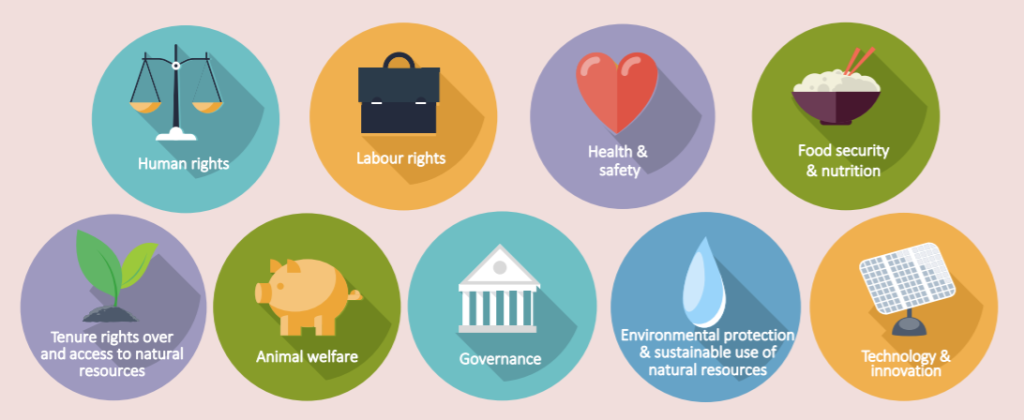This post by Shivani Kannabhiran and Rena Hinoshita from the OECD Centre for Responsible Business Conduct looks at the EU’s new Farm to Fork strategy and at how the OECD-FAO Guidance for Responsible Agricultural Supply Chains can help companies build resilient and sustainable supply chains.
The EU food and agricultural sector is a global provider of safe, nutritious and quality food. The sector employs 33 million people and supports nearly 30,000 companies, most of whom are SMEs. The sector has also taken steps to reduce its greenhouse gas emission by 20% since 1990.[1] However, it still accounts for 10.3% of the EU’s total GHG emissions. Excessive use of nutrients and chemical pesticides contributes to biodiversity loss in Europe and has a significant impact on water, air and soil quality.[2] Thirty three million people in the EU cannot afford a quality meal every second day while about 20% of food produced is wasted.[3] At the same time, the obesity rates of European adults and children have been on the rise for years. The COVID-19 pandemic further highlights the fragility and importance of resilient agricultural supply chains.
Published earlier this year, the EU’s comprehensive Farm to Fork strategy will strive to address these challenges and to ensure a fairer, healthier and more environmentally-friendly food system as set out in the European Green Deal. The OECD-FAO Guidance for Responsible Agricultural Supply Chains can contribute to the success of this strategy by providing practical recommendations for companies operating in European agricultural supply chains.
How can the OECD-FAO Guidance help?

The OECD-FAO Guidance covers a broad range of supply chain risks faced by the sector. These risks include food security and nutrition; the environmental concerns such as deforestation, GHG emissions, and biodiversity loss; human and labour rights; tenure rights over and access to natural resources; and animal welfare. The guidance provides examples of risk mitigation measures which companies can take to prevent and address risks and contribute to global commitments, such as the SDGs and the European Green Deal.
What makes the OECD-FAO Guidance practical tool?
The guidance recommends a five-step framework for due diligence which companies can adapt and integrate into existing management systems. This framework, developed in close collaboration with businesses, investors, civil society, worker representatives, policy makers and supply chain experts, is increasingly being considered in mandatory approaches to due diligence.

A few characteristics make the guidance particularly useful for businesses operating in complex supply chains. The guidance recognises that due diligence is commensurate with risk. This “risk-based” approach means that if the likelihood and severity of an adverse impact is high, then due diligence should be more extensive. The guidance also acknowledges that it may not be feasible to address all identified risks at once. Companies are allowed to prioritise actions based on the severity and likelihood of the adverse impact. The more severe the impact, the higher it should be on a company’s priority list. Finally, the guidance recognises that companies and stakeholders along the value chain have an interest to work together to be provide for effective due diligence, to address deep rooted, complex risks and, where relevant, provide for remediation.
How does the OECD support uptake of the OECD-FAO Guidance?
The OECD works closely with policy makers, business and investors to promote awareness of the guidance and coherence in policy making to support responsible business actions. In addition, the National Contact Points for Responsible Business Conduct provide a mediation and remedy platform when complaints alleging non-observance of OECD recommendations are lodged.
In 2018, the OECD and FAO initiated a pilot project with over 30 companies and industry initiatives in the agricultural sector. The pilot found that many companies have made commitments to international standards and have reasonable management systems in place to identify risks. However, gaps remain in how comprehensive risk policies are and in the extent to which companies translate policy commitments into action. Many companies also rely on third party certification programmes which may or may not align with international expectations on due diligence.
This has prompted the OECD and FAO to scale up uptake of the OECD-FAO Guidance and to foster alignment of the recommendations with key actors in global agricultural supply chains.
The EU’s call to action to the food and agricultural sector is inspiring and timely. Let us respond to this ambitious call by accelerating the promotion of the OECD-FAO due diligence approach to prevent and address risks in global supply chains. The EU’s Farm to Fork Strategy can help to meet citizens’ expectations on responsible business and to demonstrate continued EU leadership in the food and agricultural sector. Together we can create a resilient and sustainable food system in the EU and globally.
[1] From 543.25 million gigatons of CO2 equivalent in 1990 to 438.99 million gigatons in 2017, Eurostat (2020)
[2] OECD (2018) Human Acceleration of the Nitrogen Cycle https://doi.org/10.1787/9789264307438-en; European Commission (2020) Farm to Fork Strategy
[3] EU FUSIONS (2016). Estimates of European food waste levels
Further reading:

